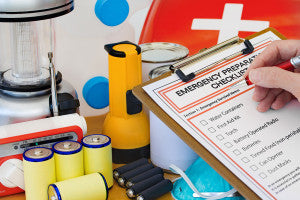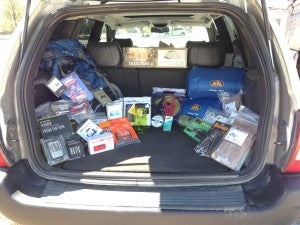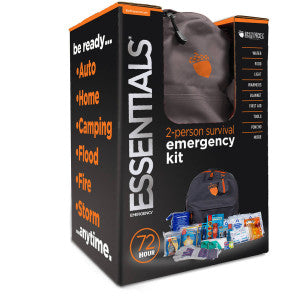What is an Emergency Kit?

An emergency kit,
according to Ready.gov, is “simply a collection of basic items your household may need in the event of an emergency.” Many of the items found in your personal emergency kit may vary from person to person (due to personal circumstances), but the majority should remain constant.
Emergency kits are your bread and butter during times of disaster and other crises. Everything inside should help you get through whatever disaster comes your way. Of course, all disasters come with different challenges, but the basic necessities will always remain unchanged. Which brings us to the next question…
What Should an Emergency Kit Contain?
Keep what you need to survive. What do you need in an emergency? The obvious answers are food and water. But that’s just the beginning. With more gear and tools, you will have a much easier time getting through your crisis.
The following list is what
Ready.gov recommends you have in your emergency kit (and should last you for at least three days):
-
 Water
Water
- Food
- Radio
- Flashlight
- First aid kit
- Whistle
- Dust mask
- Moist towelettes, garbage bags
- Wrench or pliers
- Can opener
- Maps
- Cell phone charger, inverter, or solar charger
All these items serve an important purpose for not just survival, but obtaining whatever comforts you can when everything else is out of reach. Whistles are essential for calling for help without wasting too much energy. Moist towelettes can be used for sanitary needs. Food for eating. Water for drinking. Well, you get the idea. Everything in your kit should help you succeed during a disaster.
What Should You Do With Your Kit?
Emergency kits are to be used in the event of an emergency (as the name implies). That means it must be ready when an emergency happens. If your kit has sat unused for years, there’s a chance some of the items won’t be usable when the time comes.
Flashlight batteries could be dead, food could be old and bad, and other things could be wrong with the contents if you haven’t looked through it in a while. Ideally, you should be checking your emergency kits every six months, rotating your food, water, and other gear when necessary.
Keep it Handy
It would be great if we could plan when and where disasters strike. That way we would always be ready. But, as life would have it, controlling those outside factors just isn’t something we are able to do. Usually, disasters give us little or no warning, which means you’ll need to act fast when a crisis comes for a visit. And, since you never know where you’ll be when disaster strikes, it’s ideal to have an emergency kit in many different locations.
Home
You spend a lot of time at home. If nothing else, it’s where you sleep, and many disasters have been known to wait until the wee hours of the morning before making their presence known (i.e. tornadoes, earthquakes, etc.). Having an emergency kit at home is vital to your success, day or night.
Speaking of night, it’s never so dark as when the power’s out and you’re looking for your gear. That’s one reason why it’s imperative to store your emergency kit in an easy to reach location. Likewise, disasters may force you from your home without a moment’s notice (much like those who
fled the wildfires in Fort McMurray, Alberta). When this happens, you grab what’s available and get out of there. By having your emergency kit in a handy, easy to reach location (such as your front closet), your emergency kit becomes your bug out bag, which will help you get through the next 72 hours of uncertainty.
Vehicle
[caption id="attachment_17975" align="alignright" width="300"]

All these emergency items can pack up small for maximum trunk space.[/caption]
From
mudslides in California to snowy roads in many other parts of the country, your road trip can take a turn for the worst without so much as a warning. Drivers have been
stranded in their car for days, relying on whatever provisions they had for their road trip to see them through until help arrived. Usually, it’s just a few snacks, rather than anything substantial. By having an emergency kit in your vehicle, you can not only have the food and water needed for survival, but tools to help get your car unstuck and back on the road. At the very least, you can have ways to call or signal for help.
Work
Aside from your home, you spend quite a bit of time (too much, perhaps?) at the office. Replace out what your business’s emergency contingency plan is. If they already have kits for their employees, great! But chances are you’re on your own in that regard. Put an emergency kit together to put in your locker, slide under your desk, or somewhere else it will fit.
School
Your kids deserve to be ready for anything, and you can help them. There are many instances in which your children may have use for a mini emergency kit, such as a school lock down, severe weather, bus accident, and more. Just like any kit, your children’s school emergency kits should have water, food, an emergency whistle, a first aid kit, and other essential items. Of course, this kit should be small, so as to fit in the bottom of your children’s backpacks. Additionally, have your children keep another emergency kit in their locker. This way, they can have larger items (such as an emergency blanket) already at the school should they need it. For more information, the
Mom with a Prep blog discusses what each child’s emergency kit should contain, as well as why it’s necessary.
Get Your Own Emergency Kit
Now that you know more about emergency kits, the next step is to acquire one of your own. You can either make one yourself, buy a pre-assembled kit, or add to an already assembled kit with your own customizations and personalizations.
Purchase a Pre-Assembled Emergency Kit
We’ve put together a wide range of pre-assembled emergency kits, containing all the basics you need for various situations.
Check out our line of emergency kits and get the one(s) that will best suit your needs. Once you have your kit, feel free to add to it. You might include personal documents, extra flashlights, and anything else feel you may need.
Make Your Own
If you already have everything you need for your kit, or you just want to use
other products not in our pre-assembled kits, you can make your own easily by getting a backpack and filling it with all the supplies you need (see above for a list of important items). Or, you could make a hybrid by taking one of our kits and adding other items of your choosing.
When emergencies strike, you’ll want some basic supplies to help keep yourself safe and healthy. Emergency kits, when properly packed with frequent rotations of items, are the ideal resource to help see you through those tough times. Keep them in your home, in your car, and at work and school. After all, you never know when or where a disaster will strike. But when you’re prepared, there’s nothing you can’t handle.
Click here to shop our emergency kits.

 An emergency kit, according to Ready.gov, is “simply a collection of basic items your household may need in the event of an emergency.” Many of the items found in your personal emergency kit may vary from person to person (due to personal circumstances), but the majority should remain constant.
Emergency kits are your bread and butter during times of disaster and other crises. Everything inside should help you get through whatever disaster comes your way. Of course, all disasters come with different challenges, but the basic necessities will always remain unchanged. Which brings us to the next question…
What Should an Emergency Kit Contain?
Keep what you need to survive. What do you need in an emergency? The obvious answers are food and water. But that’s just the beginning. With more gear and tools, you will have a much easier time getting through your crisis.
The following list is what Ready.gov recommends you have in your emergency kit (and should last you for at least three days):
An emergency kit, according to Ready.gov, is “simply a collection of basic items your household may need in the event of an emergency.” Many of the items found in your personal emergency kit may vary from person to person (due to personal circumstances), but the majority should remain constant.
Emergency kits are your bread and butter during times of disaster and other crises. Everything inside should help you get through whatever disaster comes your way. Of course, all disasters come with different challenges, but the basic necessities will always remain unchanged. Which brings us to the next question…
What Should an Emergency Kit Contain?
Keep what you need to survive. What do you need in an emergency? The obvious answers are food and water. But that’s just the beginning. With more gear and tools, you will have a much easier time getting through your crisis.
The following list is what Ready.gov recommends you have in your emergency kit (and should last you for at least three days):
 Water
Water All these emergency items can pack up small for maximum trunk space.[/caption]
From mudslides in California to snowy roads in many other parts of the country, your road trip can take a turn for the worst without so much as a warning. Drivers have been stranded in their car for days, relying on whatever provisions they had for their road trip to see them through until help arrived. Usually, it’s just a few snacks, rather than anything substantial. By having an emergency kit in your vehicle, you can not only have the food and water needed for survival, but tools to help get your car unstuck and back on the road. At the very least, you can have ways to call or signal for help.
Work
Aside from your home, you spend quite a bit of time (too much, perhaps?) at the office. Replace out what your business’s emergency contingency plan is. If they already have kits for their employees, great! But chances are you’re on your own in that regard. Put an emergency kit together to put in your locker, slide under your desk, or somewhere else it will fit.
School
Your kids deserve to be ready for anything, and you can help them. There are many instances in which your children may have use for a mini emergency kit, such as a school lock down, severe weather, bus accident, and more. Just like any kit, your children’s school emergency kits should have water, food, an emergency whistle, a first aid kit, and other essential items. Of course, this kit should be small, so as to fit in the bottom of your children’s backpacks. Additionally, have your children keep another emergency kit in their locker. This way, they can have larger items (such as an emergency blanket) already at the school should they need it. For more information, the Mom with a Prep blog discusses what each child’s emergency kit should contain, as well as why it’s necessary.
Get Your Own Emergency Kit
Now that you know more about emergency kits, the next step is to acquire one of your own. You can either make one yourself, buy a pre-assembled kit, or add to an already assembled kit with your own customizations and personalizations.
Purchase a Pre-Assembled Emergency Kit
We’ve put together a wide range of pre-assembled emergency kits, containing all the basics you need for various situations. Check out our line of emergency kits and get the one(s) that will best suit your needs. Once you have your kit, feel free to add to it. You might include personal documents, extra flashlights, and anything else feel you may need.
Make Your Own
If you already have everything you need for your kit, or you just want to use other products not in our pre-assembled kits, you can make your own easily by getting a backpack and filling it with all the supplies you need (see above for a list of important items). Or, you could make a hybrid by taking one of our kits and adding other items of your choosing.
When emergencies strike, you’ll want some basic supplies to help keep yourself safe and healthy. Emergency kits, when properly packed with frequent rotations of items, are the ideal resource to help see you through those tough times. Keep them in your home, in your car, and at work and school. After all, you never know when or where a disaster will strike. But when you’re prepared, there’s nothing you can’t handle.
Click here to shop our emergency kits.
All these emergency items can pack up small for maximum trunk space.[/caption]
From mudslides in California to snowy roads in many other parts of the country, your road trip can take a turn for the worst without so much as a warning. Drivers have been stranded in their car for days, relying on whatever provisions they had for their road trip to see them through until help arrived. Usually, it’s just a few snacks, rather than anything substantial. By having an emergency kit in your vehicle, you can not only have the food and water needed for survival, but tools to help get your car unstuck and back on the road. At the very least, you can have ways to call or signal for help.
Work
Aside from your home, you spend quite a bit of time (too much, perhaps?) at the office. Replace out what your business’s emergency contingency plan is. If they already have kits for their employees, great! But chances are you’re on your own in that regard. Put an emergency kit together to put in your locker, slide under your desk, or somewhere else it will fit.
School
Your kids deserve to be ready for anything, and you can help them. There are many instances in which your children may have use for a mini emergency kit, such as a school lock down, severe weather, bus accident, and more. Just like any kit, your children’s school emergency kits should have water, food, an emergency whistle, a first aid kit, and other essential items. Of course, this kit should be small, so as to fit in the bottom of your children’s backpacks. Additionally, have your children keep another emergency kit in their locker. This way, they can have larger items (such as an emergency blanket) already at the school should they need it. For more information, the Mom with a Prep blog discusses what each child’s emergency kit should contain, as well as why it’s necessary.
Get Your Own Emergency Kit
Now that you know more about emergency kits, the next step is to acquire one of your own. You can either make one yourself, buy a pre-assembled kit, or add to an already assembled kit with your own customizations and personalizations.
Purchase a Pre-Assembled Emergency Kit
We’ve put together a wide range of pre-assembled emergency kits, containing all the basics you need for various situations. Check out our line of emergency kits and get the one(s) that will best suit your needs. Once you have your kit, feel free to add to it. You might include personal documents, extra flashlights, and anything else feel you may need.
Make Your Own
If you already have everything you need for your kit, or you just want to use other products not in our pre-assembled kits, you can make your own easily by getting a backpack and filling it with all the supplies you need (see above for a list of important items). Or, you could make a hybrid by taking one of our kits and adding other items of your choosing.
When emergencies strike, you’ll want some basic supplies to help keep yourself safe and healthy. Emergency kits, when properly packed with frequent rotations of items, are the ideal resource to help see you through those tough times. Keep them in your home, in your car, and at work and school. After all, you never know when or where a disaster will strike. But when you’re prepared, there’s nothing you can’t handle.
Click here to shop our emergency kits.


